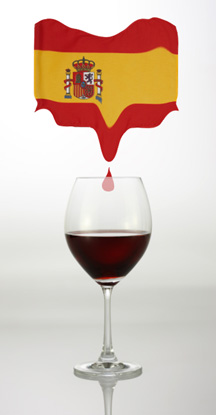 I was reminded yesterday of what elusive element it was that made me fall incorrigibly in love with wine a couple of decades ago, and what that element means to me today with the oceans-worth of wines that are out there being made. Wine writers, makers and marketers often throw around the word terroir as if it were some mystical, unattainable, spiritual ether—and oftentimes that makes them easy targets for those that poo-poo the idea of terroir as a gimmick—but those of us that have managed to shut up just long enough to hear a wine speak of place know that those are the only ones worth really seeking out in life. This isn’t all to say that a wine always needs to be “serious” and thought provoking, as sometimes the simplest of pleasures are not only satisfying but also gratifying. But what wine should be at all times is a resident. If it can’t tell me where it’s from, I lose interest…quickly.
I was reminded yesterday of what elusive element it was that made me fall incorrigibly in love with wine a couple of decades ago, and what that element means to me today with the oceans-worth of wines that are out there being made. Wine writers, makers and marketers often throw around the word terroir as if it were some mystical, unattainable, spiritual ether—and oftentimes that makes them easy targets for those that poo-poo the idea of terroir as a gimmick—but those of us that have managed to shut up just long enough to hear a wine speak of place know that those are the only ones worth really seeking out in life. This isn’t all to say that a wine always needs to be “serious” and thought provoking, as sometimes the simplest of pleasures are not only satisfying but also gratifying. But what wine should be at all times is a resident. If it can’t tell me where it’s from, I lose interest…quickly.
It happened to be that while these thoughts were hitting home I was drinking a sample wine sent to me for review—Marco Real’s 2007 Tempranillo from the Navarra region of Spain. Navarra is most well known for its merlots believe it or not, but I was drawn to this bottle because, of all the samples sent it was the only one that was 100% tempranillo, a grape most famously hailing from the Rioja region which sits just south of Navarra. Spain in general has seen quite a revolution with its young winemakers, many of whom are pursuing a more “modern” taste profile for their wines. While I’m busy waxing eloquent about old world Riojas like R. Lopez de Heredia, these young guns are running as far away from that style of wine as possible, aiming instead for a California-like wine that clubs you over the head like an enological 2 x 4. So when I poured this young wine into a glass, its inkiness took me by surprise. It looked more like a fucking zinfandel than it did a tempranillo…and, in fact, it tasted more like one, too.
What I thought to myself was, this wine could come from anywhere. And if that’s the case, then this wine comes from nowhere. There was absolutely no way to have pegged this as a Spanish tempranillo (perhaps I’m at fault for constantly comparing it to its more elegant Rioja brethren, but…well…tough shit.) I wanted some sort of bearing—some sort of sense of home—but what I got was a wine that, while tasting OK, couldn’t be pegged as a resident. Call it, for lack of a better term, a wine “without country”. And while it’s certainly worth its $10 price tag as a technically unflawed, completely potable wine, I don’t have enough years left in my life to spend them on wines that are lost.
I want wines that have an identity…wines that have a personality…wines that, for better or worse, have a home, because it helps complete my experience in drinking them. I can close my eyes and taste a dozen chardonnays that have been manipulated eighty ways ‘til Sunday and not be able to discern whether they were made in California, Australia or Chile—I have no connection to them because they are commodities. Why would I ever want to bother with something I can’t connect with? These aren’t of any use to me…they don’t matter. Even the simplest of rosés from Provence, ever quaffable on a hot afternoon, matters because it differentiates itself from a rosé made in Tavel, and it sure as hell differentiates itself from the gallons and gallons of “white zinfandel” being made today. This isn’t any deep, esoteric soul search for Christ’s sake…it’s arguing a case for point of origin. I simply don’t have the time or the inclination to spend on wines that can’t show me what there home is like, and as I get older, my patience wears thin for those wines that don’t have a map and compass.




{ 15 comments… read them below or add one }
There’s so much nowhere wine out there– Love the “wine without a home” thought.
Though- I’d struggle to say people are making wine “California-like” – Freakshow homogenization is an international phenom, and there are some peeps here (CA) pulling serious dirt and place from their land and getting it into their juice.
Thanks for the comments, Hardy! But I respectfully disagree and I’ll tell you why…while Freakshow homogenization is DEFINITELY an international phenom, and there are DEFINITELY some people in CA seriously taking their sense of place into account, what I meant by that statement (and I think that most would agree) is that the winemakers that are seeking to mimic “new world” concentration and forwardness are almost always using CA’s fruitbombs as their source of inspiration. They point in that direction and say “I want to make wines like THAT because THAT is what Americans want.” Know what I mean?!
To quote the Hosemaster, “Terroir is French for “April Fools”. And on that note, Umami is a Japanese word with the same definition… …but seriously I’m tired of the fad of overextracted wine, matter not where it is from.
Given America’s penchant for taking both good and bad ideas and running them completely into the ground, we can probably rest assured that before we know it all cabs and chards will swing with the pendulum and be made without oak, and all zinfandels and Rhone varieties will be picked greener, etc…..ugh.
I really just like wine that tastes good. Am I wrong for thinking and drinking that way? I might note that a cabernet does not taste like a cabernet, but if it still tastes good, why should that bother me? I’m more bothered by wine that is varietally correct but tastes like shit
Of course you aren’t wrong for drinking that way, it’s the thinking part that ceases to exist. If wine is only about taste for you (i.e. does this TASTE good) then that’s where it begins and ends for you….for me it doesn’t. And this wasn’t at ALL about a cabernet tasting “like a cabernet” because I think that’s an inherently wrong way to look at wine. What I’m saying is that cabernet made in Bordeaux should taste DIFFERENT than cabernet from Chile, which should taste different than a cabernet from Napa. These places are all radically different, thus the wines should be different, but many aren’t…..THAT is what I can’t be bothered with. It may taste fine, but if it doesn’t reflect its home in any way, then it might as well be made in a factory in East Bumfuck. I don’t want a winery to sell me vineyards and give me factory.
the East Bumfuck AVA is one of my all time favorites…they are known for their Rhone Varietals though
That’s a Jersey AVA by the way, but much like East Paterson, East Bumfuck will most likely soon be changed to Elmwood Briar so as not to be associated with the town of Bumfuck.
Bastards!!!
Sorry to disagree with you, but we have only seen a handful of Navarran wines in this country over the past decade and ALL of them were either predominantly Tempranillo or 100% Tempranillo. The comparisons with Rioja are appropriate (although Bordeaux varieties do seem more prevalent in this region than other northern Spanish regions), for historical and terroir reasons, as well as the predominance of Tempranillo. And, no, I have never tasted a Navarran Merlot…
You’re welcome to disagree with me, but recently (less than a year ago) I took a course to become certified as a Spanish wine instructor, and the discussion of Navarra included a great deal about its merlots being the best in Spain…this doesn’t mean that the bulk of its wine is merlot, but that it is most well known for them because they are supposedly the “best” in the country. And to their point, the shipment of samples I recently received, which promoted the region of Navarra, contained a couple that contained either tempranillo or garnacha, but all the others were Bordeaux-style blends, mostly with merlot.
So though I do agree with you that the Navarran wines in the US are nearly all tempranillo, that’s not the best of what Navarro supposedly has to offer according to the Spaniards.
I vaguely remember Navarra being best known for good rosés & light clarets- mostly Garnacha-based. Rioja Alavesa blends (Álava being inland Euskadi pretty much South of Navarra, if my mental map doesn’t betray me) would be slightly different from other Riojas in alo including Garnacha– rather than Mazuelo/Carignan?– now *that’s* Basque terroir, no?
Absolutely right on the rosés, David…those are Navarra’s other “claim to fame”. But as of late, the younger wine makers are planting more and more of the Bordeaux varieties to see how they fair in Navarra. Despite the fact that garnacha and mazuelo (in addition to tempranillo) are “native” to the region, they want to fly in the face of all that apparently.
Katie,
My affinity for this post is undermined with words. All I can say is that it is incredibly encouraging to know that someone else shares a philosophy I hold so near and dear to my heart.
Unfortunately, the vast majority of the general public is not familiar with the concept of “terroir”, let alone able to appreciate its manifestation in wine. And more importantly (or tragically), even if this were not true, I still fear that the glamorous seduction of the delicious-factor would ultimately beat out sense of place. In other words, even if the vast majority of people out there did understand the concept of “terroir”, and were able to appreciate its manifestation in wine, I think most would still choose soulless extracted flavor over “residence”.
I’m convinced that this inevitable majority-preference is the result of our current culture and its values, and the sad truth that anyone seeking wines of terroir must ultimately realize, is that in a world where sensation and materialism reigns supreme, that which is genuine (and therefore meaningful) will never be king.
However, one should not lose hope…. there is talk in the streets that a revolution is coming 😉
– Elliot K.
– w w w . t r u e t e r r o i r . c o m
It is very true that most of the general public is not familiar with the concept of terroir, mainly because the industry has not done its job to educate…a by-product of the goal to homogenize rather than differentiate. I also completely agree that even if the public were more knowledgeable about it, it would probably still grab for the “same-old, same-old” overall. But I do think that if you get a hold of those who are newly passionate about wine, and turn them on to terroir first-hand, in side-by-side comparisons, the light bulbs might just begin to go on….hope, as you said. But part of me is shamefully glad that many of the wines that speak of home are NOT popular because it keeps their prices at bay! 🙂